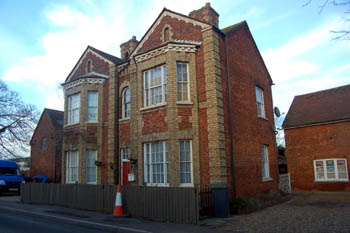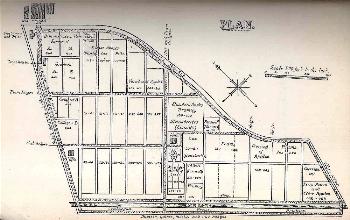
The Fruit Farm January 2008
The Fruit Farm is an attractive 19th century building which used to stand in an otherwise quite an isolated location close to Ridgmont Station. It is now hemmed in by the industrial estate built on the site of the Coronation Brickworks (which itself dated from 1930), the M1 motorway and the overhead section of the road from Ampthill which joins the A421 at Junction 13.
The Woburn Experimental Fruit Farm was set up in 1895 by Herbrand, 11th Duke of Bedford in twenty acres of land close to Ridgmont Station. The ground was prepared for fruit growing in June 1894 having been used for arable crops hitherto. Bedfordshire and Luton Archives and Records Service is lucky in having the first two reports written by the Duke and Percival Spencer Umfreville Pickering (1858-1920) in 1897 and 1900 as well as a book called Science and Fruit Growing written by the same authors. These are available on the shelves of the Searchroom library.
The farm was a private venture between the Duke and Pickering and independent of the Woburn Experimental Farm which was then run by the Royal Agricultural Society of England, later by the Lawes Agricultural Trust. The duke provided the land and the finance and Pickering directed the farm and its experiments. In A Great Agricultural Estate, written in 1897, also in the Searchroom library, the duke wrote: "The object of the institution is not that of supplying a model of what a fruit farm should be, nor is it that of testing or demonstrating the possibility of growing fruit in the district as a commercial success; its main object is to supply a want which has been felt by all who have given serious attention to the culture of fruit, by providing an establishment where any matters connected with fruit growing, whether of practical or of purely scientific interest, may be investigated in a rigorously scientific manner; it is, in short, an experimental station, where horticultural questions and problems are dealt with in the same manner as agricultural questions are at the station of the Royal Agricultural Society".
The greater part of the farm was occupied by apple trees. As can be seen from the plan below found in the First Report of 1897 however, pears, plums , cherries, currants, damsons, quinces, medlars, gooseberries, raspberries, strawberries and hazelnuts were also grown. Another sketch map held at Bedfordshire and Luton Archives and Records Service (too large to scan) shows the layout of the farm in 1920 [R1/418].

The layout of the Fruit Farm in 1897 - to see a larger version please click on the image
The experiments at the fruit farm seem to have ended with the death of Spencer Pickering in 1920. Later that year E. J. and W. G. Hobbs leased the farm from the Duke of Bedford for commercial fruit growing. The Rating and Valuation Act 1925 specified that every building and piece of land in the country was to be assessed to determine its rateable value. The valuer visiting the Fruit Farm [DV1/A8/35] described it as being at Well End. The house comprised three living rooms, a kitchen, a scullery and four bedrooms above. Outside stood an earth closet, a coal barn, a brick and slate potato store, a coachhouse with a loft over, a mixing house with a loft over and a brick and tiled hovel.
On the opposite side of the road stood a wood and thatched store house. There was also a workshop and six wood and corrugated iron pigsties, a vinery and heated glasshouses measuring 12 feet by 30 feet, 12 feet by 12 feet 6 inches and 9 feet by 20 feet 6 inches with a wood and corrugated iron stokehole. The 20 acres, 1 rood, 17 poles of land were leased for £18/10/- per annum. The valuer commented: "Long way away from village".
The house existed before the conversion of the land to a fruit farm. It is shown on the 1st Edition 25 inches to the mile Ordnance Survey map of 1883.
Directories for Bedfordshire, which were not published annually but every few years, give the names of the occupiers of the Fruit Farm from 1898 to 1940and the following names are taken from these directories. The dates are those of the first and last appearance of a name, not the full span of dates of residence:
- 1898-1903: Lewis Castle, manager
- 1906-1910: William Herbert Neild, local manager
- 1914-1920: Spencer Pickering, director, William Herbert Neild, local manager;
- 1924-1940: E. J. and W. G. Hobbs, fruit growers.
Registers of Electors tell us that the Hobbs family remained at the Fruit Farm until late 1976 or early 1977. In December 1977 plans were submitted for alterations to the house and its outbuildings [PL/P/MB77/1243].
In 2011 the Fruit Farm was put up for sale. The sale particulars described the farmhouse comprising: an entrance hall measuring 20 feet 7 inches by 6 feet 6 inches decreasing to 5 feet; a cloakroom with a W. C., three receptions rooms measuring, respectively, 13 feet 7 inches by 9 feet 1 inch, 13 feet 8 inches by 9 feet 1 inch and 13 feet 7 inches by 11 feet 5 inches; a breakfast room measuring 12 feet 3 inches by 11 feet 3 inches and a kitchen/dining room measuring 17 feet 2 inches by 15 feet 4 inches. Upstairs lay five bedrooms, measuring, respectively: 9 feet by 13 feet 9 inches; 13 feet 7 inches by 9 feet; 13 feet 5 inches by 11 feet 3 inches; 8 feet 3 inches decreasing to 5 feet 6 inches by 7 feet 7 inches and 12 feet by 3 feet 6 inches increasing to 6 feet 10 inches.
Outside lay: a two storey barn measuring 44 feet by 14 feet 9 inches on each floor; an attached warehouse measuring 30 feet 7 inches by 22 feet 7 inches and a detached two storey cottage used as an office, the ground floor measuring 12 feet 11 inches by 14 feet 8 inches; a bathroom measuring 6 feet 3 inches by 5 feet 6 inches; a utility/store room measuring 6 feet 6 inches by 5 feet 1 inch and a first floor room measuring 14 feet 8 inches by 13 feet. There were also dog kennels.